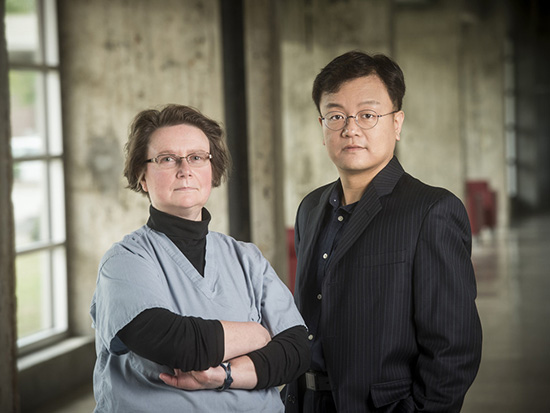 Brigitta Brott, M.D., and Ho-Wook Jun, Ph.D.
Brigitta Brott, M.D., and Ho-Wook Jun, Ph.D.
Photography: Steve WoodNarrowed arteries can restrict blood flow to the heart. One treatment is inserting a stent — a small mesh tube — inside the artery to widen it. However, existing stents have problems that affect their performance.
Two University of Alabama at Birmingham researchers have been awarded a $2.6 million, four-year National Institutes of Health grant to evaluate a safer and more durable stent design, using techniques licensed through the UAB Harbert Institute for Innovation and Entrepreneurship by their UAB spinoff company, Endomimetics LLC.
Ho-Wook Jun, Ph.D., is principal investigator in the grant, and Brigitta Brott, M.D., is the co-investigator. They are co-founders of Endomimetics and have worked together for a decade to develop their bionanomatrix material for coating stents to improve heart disease treatment. Their material has other potential applications in patients with brain aneurysms, kidney dialysis patients and patients with percutaneous osteointegrated prostheses.
“This public-private partnership of UAB and Endomimetics is an excellent example of the way publicly funded research can be translated to tangible products and services that will significantly improve the lives of the people in both Alabama and the world,” Jun said. At UAB, Jun is a professor in the UAB Department of Biomedical Engineering, and Brott is an interventional cardiologist and professor in the UAB Department of Medicine Division of Cardiovascular Disease. At Endomimetics, Jun is chief scientific officer, and Brott is chief medical officer.
Jun and Brott say that bare metal stents are limited by a subsequent overgrowth of cells inside the stent, called neointimal hyperplasia, that is caused by vascular injury during stent implantation. This can lead to blockage inside the stent.
To reduce this restenosis, drug-eluting stents, coated with anti-proliferative agents that target neointimal hyperplasia, have been developed. However, recent studies have revealed that the clinically used dose of anti-proliferative drugs for these stents may cause serious adverse effects. These include damage to the endothelium that delays re-endothelialization, with impaired functions, and an inflammatory response to the polymer coating that delivers the anti-proliferative drugs.
“We have successfully developed the nitric oxide-releasing, prohealing, multifunctional endothelium-mimicking bionanomatrix stent coating capable of providing the chemical and biological properties of the native endothelium,” Jun said. Jun says the coating has been demonstrated in vitro, ex vivo and in a balloon-injury iliac artery model in healthy rabbits. “Notably, we recently found that nitric oxide has significant potential to salvage endothelial cell proliferation and migration from the adverse effects of anti-proliferative drugs, while synergistically suppressing smooth muscle cell proliferation.”
“A major issue with the study of stents is that outcomes derived from experimentation using healthy animal model studies — with or without balloon injury — do not adequately predict problems found when stents are used in a large number of human patients,” Jun said. “Thus, there is a critical need to develop an innovative strategy for stent coating and stent evaluation in an atherosclerosis model, in order to address the adverse effects of clinical doses of anti-proliferative drugs and the overly optimistic findings when evaluating stents in a healthy rabbit model.”
The UAB researchers will develop novel engineered artery sheets that have atherosclerotic features. Then the efficacy of the dual-action, prohealing bionanomatrix coating can be compared with commercial bare metal stents and commercial drug-eluting stents under atherosclerotic conditions, using the engineered artery sheets and in a high-fat diet rabbit model.
“If successful, this novel strategy of the dual action bionanomatrix will advance the field by overcoming the current limitations of bare metal stents and drug-eluting stents. It will also demonstrate the development of an improved in vivo model for stent evaluation,” Jun said. The global coronary stent market is about $8 billion.
UAB Biomedical Engineering is a joint department of the UAB Marnix E. Heersink School of Medicine and the UAB School of Engineering. Medicine is a department in the Heersink School of Medicine.
